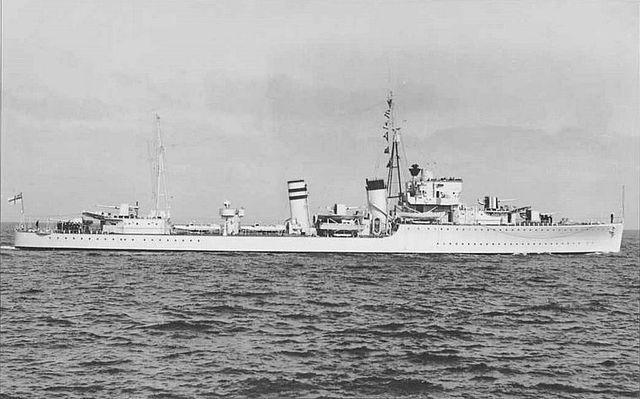HMS Glowworm was a G-class destroyer built for the Royal Navy in the mid-1930s. During the Spanish Civil War the ship spent part of 1936 and 1937 in Spanish waters, enforcing the arms blockade imposed by Britain and France on both sides of the conflict. Glowworm was transferred from the Mediterranean Fleet shortly after the beginning of World War II to the British Isles, to escort shipping in local waters. In March 1940, she was transferred to the Home Fleet, just in time to participate in the opening stages of the Norwegian Campaign. On 8 April 1940 Glowworm encountered German destroyers transporting troops to invade Norway in Operation Weserübung. The German destroyers attempted to disengage while calling for help from the heavy cruiser Admiral Hipper. In the chaos of battle, the heavily damaged Glowworm rammed Admiral Hipper. The collision broke off the destroyer's bow, and she sank shortly afterwards.
The commander of Glowworm was awarded the VC at the recommendation of the commander of Hipper. There were only two other occasions when a VC was awarded at the recommendation of the enemy in the Second World War.

Broadside view of Glowworm
Badge of HMS Glow-worm
Glowworm on fire
The G- and H-class destroyers were a group of 18 destroyers built for the Royal Navy during the 1930s. Six additional ships being built for the Brazilian Navy when World War II began in 1939 were purchased by the British and named the Havant class. The design was a major export success with other ships built for the Argentine and Royal Hellenic Navies. They were assigned to the Mediterranean Fleet upon completion and enforced the Non-Intervention Agreement during the Spanish Civil War of 1936–1939.
HMS Hasty in 1936
Hardy, 1936
Aerial view of Garland at low speed
Hesperus wearing dazzle camouflage showing the angular bridge front that was fitted to Hero, Hereward, and the ex-Brazilian ships







